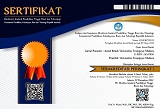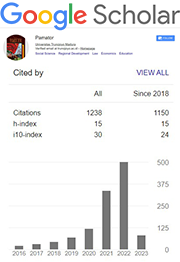Historical Trace of The Spice Road as an Economic Center Indonesian Trade and Cultural Heritage
Abstract
This research aims to explore the history of the Indonesian spice route as part of Indonesia's maritime cultural heritage and Indonesia's role in the spice trade route. The method used in this research is a descriptive qualitative approach with literature studies, utilizing various sources from books, journals and articles as well as ethnography and oral interviews. The results of the research show that the trade network connecting the eastern and western hemispheres of the world is known as the spice route and its impact. towards the development of local cultural identity of Indonesian society. The spice route not only refers to the trade and shipping route for spice products, but also as a cultural heritage whose traces can still be found, such as in culinary, art, medicine, clothing, traditions and even art. At that time, merchandise such as cinnamon, pepper, cloves, nutmeg, sandalwood, rice, cotton and others were traded. This route is a symbol that connects the maritime civilization of the archipelago which is Indonesia's national pride so that it can provide a new contribution to understanding the complexity of the interaction between economic factors and cultural heritage in shaping the historical landscape of the archipelago.
Keywords
Full Text:
PDFReferences
Baiquni, M. (2023). Spice Culture In Java As A Revitalization Of Ancient Spice Pathways And Future Progress. Jurnal Javanologi, 6(1). https://doi.org/10.20961/javanologi.v6i1.71595
Hamid, A. R. (2022a). The Role of Makassar in Promoting the Archipelago Spice Route in the XVI–XVII Centuries. Buletin Al-Turas, 28(2). https://doi.org/10.15408/bat.v28i2.25037
Hamid, Abd. R. (2022b). Jalur Rempah Dan Islamisasi Nusantara: Jurnal Masyarakat Dan Budaya, 23(3). https://doi.org/10.14203/jmb.v23i3.1065
Hofstad, H. (2023). Well understood? A literature study defining and operationalising community social sustainability. Local Environment, 28(9). https://doi.org/10.1080/13549839.2023.2195620
Kumoratih, D. (2022). Reconstructing Identity through Spice Route Narrative: An Urgency for Nation Branding? Journal of Visual Art and Design, 14(1). https://doi.org/10.5614/j.vad.2022.14.1.5
Kumoratih, D., Anindita, G., Ariesta, I., & Tholkhah, E. (2021). The role of visual communication design to increase public literacy on the history of Spice Route in supporting Indonesia’s proposal toward UNESCO’s World Cultural Heritage. IOP Conference Series: Earth and Environmental Science, 729(1). https://doi.org/10.1088/1755-1315/729/1/012107
Mufrodi, A. (2022). The Spice Route and The Sub-Urban Muslim Community in South East Asia. Sunan Kalijaga: International Journal of Islamic Civilization, 5(1). https://doi.org/10.14421/skijic.v5i1.2151
Putra, B. A. (2022). Spice Path In Compass Online Media Construction 2017-2021: Historical Perspective. Tsaqofah Dan Tarikh: Jurnal Kebudayaan Dan Sejarah Islam, 7(1). https://doi.org/10.29300/ttjksi.v7i1.6455
Setiawan, B., & Widiputera, F. (2020). Internalization strategy of conscious awareness of spices lane as national brand and national pride of Indonesian nation. Technium Social Sciences Journal, 7. https://doi.org/10.47577/tssj.v7i1.441
Sulistiono, B., & Muchsin, M. A. (2022). Portraying the tract of islam in empowering the dynamics of the potential of maritime nusantara through the spice route perspective. Miqot: Jurnal Ilmu-Ilmu Keislaman, 46(1). https://doi.org/10.30821/miqot.v46i1.899
Suroyo, Putra, B. M., & Ibrahim, B. (2021). the Development of Senapelan City As a Historical Tourism on Spice Road. Santhet: (Jurnal Sejarah, Pendidikan, Dan Humaniora), 5(2).
Sutandio, A., & Arifin, Y. Y. (2022). Cultural Representation of Chinese-Indonesians in Ca Bau Kan (The Courtesan) in the Context of Spice Trading and Nationalism. Kata, 24(2). https://doi.org/10.9744/kata.24.2.70-80
Wulung, S. R. P., Yuliawati, A. K., Abdullah, C. U., & Fitriyani, E. (2022). Spice Cultural Heritage In Geotourism Trail. Journal of Engineering Science and Technology, 17.
Yamin, M., Firmansah, Subhan, & Fadlin. (2022). Bumi Rempah Nusantara untuk Dunia: Rekontruksi dan Revitalisasi Jalur Rempah. Pendidikan Olahraga, 1(1).
DOI: https://doi.org/10.21107/pamator.v17i4.28632
Refbacks
- There are currently no refbacks.
Copyright (c) 2024 Aisyah Astinadia Siregar

This work is licensed under a Creative Commons Attribution-ShareAlike 4.0 International License.
Jurnal Pamator : Jurnal Ilmiah Universitas Trunojoyo by Universitas Trunojoyo Madura is licensed under a Creative Commons Attribution-ShareAlike 4.0 International License.















.png)